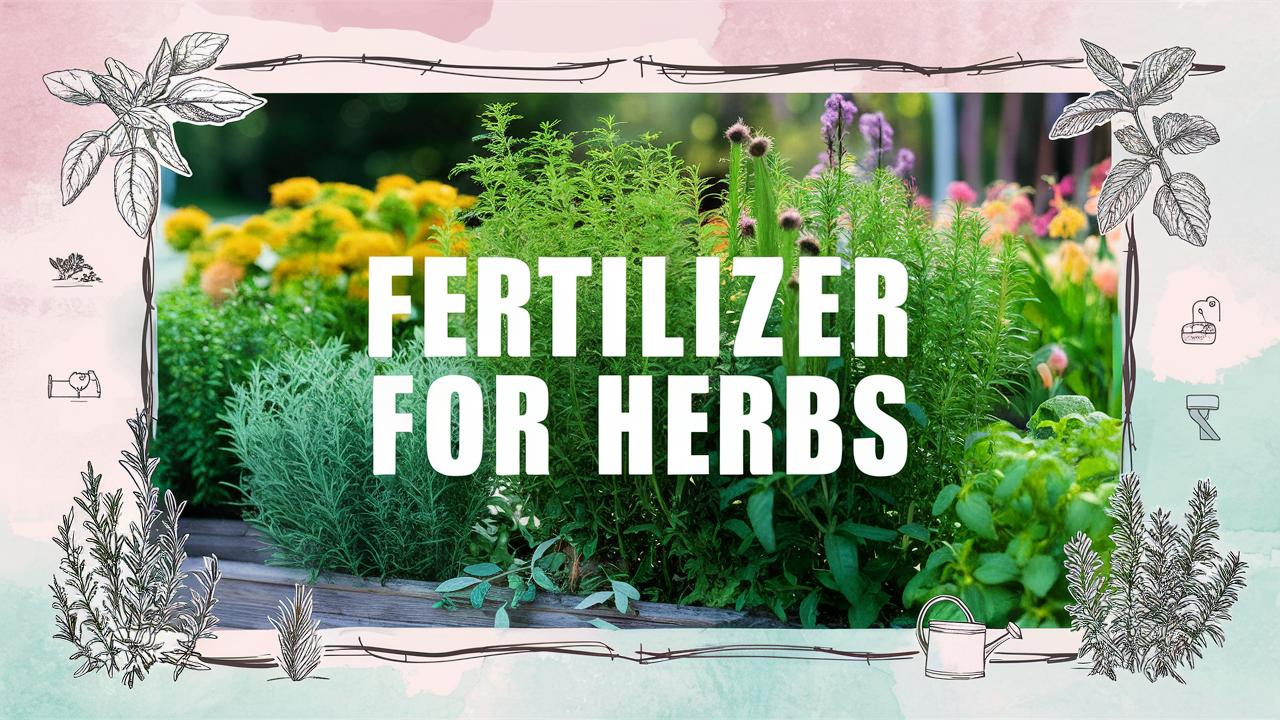In this guide, we will explore the essentials of selecting suitable fertilizers for herbs, ensuring a bountiful harvest of flavorful greens.
Fertilizer For Herbs
| Image | Name | Rating | Shop |
|---|---|---|---|
 | Herb Plant Food |  | |
 | True Organic Herb & Leafy Greens Food |  | |
 | Organic Vegetable Fertilizer |  |
Herb Plant Food
Folks who are growing edibles like herbs, leafy greens, or veggies might consider a liquid houseplant fertilizer, specifically TPS NUTRIENTS Herb Plant Food. It’s an 8 oz bottle that covers a range of plant types.
This product is specifically marketed for those cultivating edible plants. The fact that it comes in a concentrated form allows users to control the amount they apply, which can be beneficial if you’re not sure how much your plants need or want to stretch their fertilizer usage.
True Organic Herb & Leafy Greens Food
The True Organic Herb & Leafy Greens Food is a great option for those looking to provide their herbs and leafy greens with the nutrients they need to thrive. This fertilizer is designed to support lush growth in your plants, and its nutrient-rich formula ensures that your herbs will be healthy and vibrant.
This product stands out from others on the market due to its unique blend of organic ingredients, which include seabird guano, shrimp and crab shell meal, poultry manure, and more. With a generous coverage area of 70 sq. ft., this 4lb bag is perfect for home gardeners and those who practice container gardening.
Organic Vegetable Fertilizer
For herb gardeners looking to promote healthy growth and flavor in their plants, consider using Dr. Earth Organic 5 Tomato, Vegetable & Herb Fertilizer Poly Bag. This fertilizer contains a blend of natural ingredients and beneficial microbes that can help provide nutrients for an extended period.
The product’s 100% organic formula ensures that gardeners can avoid chemical-based products in favor of a more environmentally friendly option. With its ability to feed plants for several months, users will only need to apply the fertilizer periodically, reducing hassle and maintenance time in their gardening routine. By using Dr. Earth Organic Fertilizer, herb gardeners may be able to achieve more abundant and nutritious crops.
Miracle-Gro Performance Organics Edibles Plant Nutrition
Miracle-Grow’s Performance Organics Edibles Plant Nutrition is worth considering for herbal cultivation needs due to its ability to provide an instant source of organic nutrition. This OMRI listed product makes it suitable for use with herbs, tomatoes, vegetables, and fruits.
Users should follow the instructions as outlined on the packaging, applying every seven days to ensure optimal effects. When used in conjunction with the Miracle-Gro Performance Organics Garden Feeder, a single pound of fertilizer can provide coverage for up to 265 square feet of gardening space. The product’s ease of use, combined with its performance, makes it an attractive option for gardeners looking for organic alternatives to traditional fertilizers.
Herbalizer Particle
Looking for an all-natural fertilizer specifically designed for herbs like basil and mint, as well as leafy greens like lettuce and kale? Consider EcoScraps for Organic Gardening Herbs and Leafy Greens Plant Food. This 4-pound bag of plant food is formulated to provide the unique nutritional needs of these types of plants.
EcoScraps offers a clean, convenient way to feed your herb garden with no mess or fuss. The all-in-one particles ensure even application and contain everything you need for healthy growth and development – without any added waste or manure products. This product is perfect for organic gardening methods and environmentally friendly practices.
Garden-tone Organic Fertilizer
Gardeners looking to promote healthy growth in their herbs may consider using Espoma’s Organic Garden-Tone fertilizer.
This product’s suitability for both cool and warm season vegetables, including leafy greens like lettuce and kale as well as warmer climate crops such as tomatoes and peppers, aligns well with common herb cultivation needs.
EarthPods
For those looking to fertilize their herb garden with an organic and easy-to-use product, we would recommend considering 100 Earthpods – Premium Bio Organic Vegetable Fertilizer Spikes.
This product is specifically formulated for herbs and potted plants, offering a slow-release nutrient system that keeps your basil, dill, cilantro, mint, parsley, and other kitchen favorites nourished over time. The spill-free design means effortless application is guaranteed, making it suitable for both beginners and experienced gardeners alike. Made from natural ingredients in the USA, Earthpods provide a perfect balance of nutrients without any mess or hassle. They’re also ideal for small-space gardens, container gardens, and raised beds, offering a reliable solution for urban and small-space gardeners seeking to grow tasty vegetables and herbs.
Smart Grower Plant Power Up Organic Fertilizer
When it comes to choosing a fertilizer for your herbs, you want something that’s going to provide a safe and effective way to promote healthy growth. The ‘Organic Plant Food with Beneficial Microbes’ is a great option that stands out from many other fertilizers on the market.
This product is packed with natural and organic nutrients, making it perfect for vegans who want to avoid toxic chemicals in their gardening routine. With its balanced blend of essential nutrients and beneficial bacteria, this fertilizer will supercharge your plants’ growth and health. It’s also easy to use, thanks to the included scoop, making it a convenient choice for both indoor and outdoor gardening projects. Whether you’re growing herbs in pots or cultivating a full-fledged vegetable garden, this organic plant food is sure to deliver incredible results.
Understanding the Nutritional Needs of Herbs
Before diving into how to choose fertilizer, it’s crucial to understand the basic nutritional needs of herbs. Like any other plant, herbs require a balanced diet of macronutrients and micronutrients. The primary macronutrients are nitrogen (N), phosphorus (P), and potassium (K), which are often referred to as N-P-K on fertilizer packaging.
Nitrogen (N) is essential for leafy growth and is particularly important for herbs that are grown for their foliage, such as basil and cilantro. Increased nitrogen levels can lead to lush, vibrant leaves but can also make the plants more susceptible to pests and diseases.
Phosphorus (P) plays a vital role in root development and flowering. For herbs like rosemary and thyme, which can produce flowers, adequate phosphorus is necessary for robust growth and blooming.
Potassium (K) helps in overall plant health, water regulation, and enhancing the flavor profiles of herbs. Plants rich in potassium tend to have improved resistance to diseases.
Herbs also need trace elements such as magnesium, calcium, sulfur, and micronutrients like iron and manganese, albeit in much smaller quantities. Understanding these needs can guide your fertilizer selection process.
Types of Fertilizers for Herbs
When it comes to fertilizers, they can be generally categorized into two main types: organic and synthetic. Each has its advantages and drawbacks.
Organic Fertilizers
Organic fertilizers consist of natural materials, providing a slow-release source of nutrients. Here are some common types:
Compost: Rich in nutrients, compost enriches the soil gradually as it breaks down, improving soil structure over time. It’s an excellent all-purpose amendment for any herb garden.
Worm Castings: Known for their rich nutrient content and beneficial microorganisms, worm castings enhance soil fertility without the risk of over-fertilizing.
Fish Emulsion: This liquid fertilizer is high in nitrogen and provides a quick nutrient boost, making it a popular choice for leafy herbs like basil.
Bone Meal: An excellent source of phosphorus, bone meal supports root development and flowering. It’s particularly beneficial when planting new herbs.
Kelp Meal: Packed with trace minerals and growth hormones, kelp meal helps increase resistance to stress, improving overall plant vitality.
Synthetic Fertilizers
Synthetic fertilizers are chemically formulated to provide a quick and concentrated source of nutrients. They come in various formulations, often designed for specific plants or growth stages, and some offer controlled-release options. However, they can pose a risk of nutrient burn if not used correctly.
Granular Fertilizers: These can be applied directly to the soil and offer a balanced N-P-K ratio suitable for herbs. Carefully read the labels to select a formula relevant to the herbs you are growing.
Liquid Fertilizers: Quickly absorbed by plants, these are effective for spurting growth, especially during the growing season. They can be diluted in water and applied every few weeks.
Slow-Release Fertilizers: Designed to release nutrients over extended periods, these can simplify the fertilizing process by requiring less frequent applications, ideal for busy gardeners.
Comparison of Organic and Synthetic Options
When choosing between organic and synthetic fertilizers, consider factors such as your gardening philosophy, the immediate nutritional needs of your herbs, and potential long-term impacts on the soil ecosystem. Organic options encourage microbial health and soil structure, while synthetic fertilizers can give rapid results. However, some gardeners prefer the consistency and predictability of synthetic products, particularly in high-demand situations.
Assessing Your Soil Quality
Before applying any fertilizer, it’s vital to assess the quality of your soil, as soil composition can influence how well herbs will thrive. A soil test kit can help determine the pH level and nutrient content of your soil.
pH Sensitivity of Herbs
Most herbs prefer slightly acidic to neutral soil, usually pH 6.0 to 7.0. Some herbs, like chives and mint, can tolerate a little more acidity. Others, like sage and rosemary, prefer neutral conditions.
If your soil is too acidic, you can amend it with lime, while sulfur can help reduce pH levels. Testing your soil regularly can ensure a suitable environment for growth and the effective uptake of nutrients.
Soil Texture and Drainage
Soil texture and drainage capacity also play significant roles in herb growth. Sandy soils drain quickly but may require more frequent fertilization, while clay soils retain water but can become compacted. A loamy soil balances these characteristics, acting as an ideal medium for herbs. Adding amendments like perlite or peat moss can improve drainage and nutrient-holding capacity, affecting fertilizer efficacy.
Timing Your Fertilizer Application
Understanding when to fertilize is just as important as knowing what to use. The timing of your application can significantly influence the growth and flavor of your herbs.
Seasonal Timing
Most herbs demonstrate vigorous growth in the spring and summer months. This is generally the best time for both planting new herbs and fertilizing established ones. During the active growing season, applying fertilizer bi-monthly can support strong growth.
In contrast, many herbs enter a dormant phase during the fall and winter, significantly reducing their nutritional demands. During these months, reduce or eliminate fertilization to avoid stressing the plants.
Pre-Planting Fertilization
Incorporating slow-release fertilizers or organic amendments like compost into the soil before planting can provide a strong nutrient base for burgeoning herb growth. This is especially important for weaker soils that may not have enough natural fertility.
Follow-up Applications
Understanding how your specific herbs respond to fertilizer can also inform follow-up applications. Observe how plants react in terms of growth and leaf quality, adjusting your regimen as necessary. Over-fertilization can lead to excessive leaf growth with diminished flavor, which is particularly undesirable for culinary herbs.
Organic Practices in Herb Fertilization
If you choose to go the organic route, integrating practices that naturally nourish your herbs can enhance their development while benefiting the overall garden ecosystem.
Companion Planting
Companion planting involves grouping specific plants together that aid each other’s growth. Certain herbs, like basil, can promote the growth of neighboring plants through the release of natural chemicals. Additionally, planting nitrogen-fixing legumes alongside your herbs can help improve soil nitrogen availability without synthetic fertilizers.
Mulching
Applying organic mulch around your herb plants can help regulate soil temperature, retain moisture, and slowly add organic matter as it decomposes. Materials like wood chips, straw, or grass clippings can naturally fertilize while protecting your herbs.
Crop Rotation
If you have a larger gardening space, practicing crop rotation can prevent nutrient depletion. Different herbs have varying nutrient demands; rotating annual herbs where heavy feeders were grown previously can restore balance to the soil.
Recognizing Signs of Nutrient Deficiency
As you nurture your herbs, being attentive to signs of nutrient deficiency can help you address issues before they become critical. Common deficiency symptoms include:
Yellowing Leaves: This could signify nitrogen deficiency, particularly if the older leaves turn yellow first.
Stunted Growth: If herbs aren’t growing as expected, they may not be receiving adequate nutrients.
Leaf Drop: Excessive leaf drop can indicate a potassium deficiency or other imbalances.
Brittle Leaves: If leaves feel brittle or have brown edges, this may suggest a calcium or magnesium deficiency.
Arming yourself with knowledge about nutrient deficiencies can guide your fertilization practices, ensuring your herbs receive the correct treatment.
Specialty Fertilizers for Specific Herbs
While general-purpose fertilizers can work well, some herbs have unique requirements that may benefit from specialized formulas. Let’s explore a few:
Basil
Basil thrives with moderate nitrogen levels, making a balanced (N-P-K) fertilizer effective. However, applying too much nitrogen can diminish oil concentration, reducing flavor. Aim for a slow-release organic option combined with side-dressings of compost.
Cilantro
Cilantro benefits from phosphorus-rich fertilizers to support its quick growth cycle. A blend that emphasizes phosphorus can encourage healthy plants, especially in early growth stages.
Mint
Mint is a vigorous grower that can sometimes use excessive nutrients. A moderate-release organic fertilizer applied sparingly can help maintain balance and prevent overrunning nearby plants.
Rosemary and Thyme
These Mediterranean herbs prefer leaner soils. A diluted liquid fertilizer in early spring is often adequate. Over-fertilizing can lead to excessive leaf growth with diminished flavor intensity.
Conclusion
Choosing the right fertilizer for herbs is a crucial element in cultivating a flourishing herb garden. By understanding the nutritional needs of your herbs, the types of fertilizers available, the importance of soil quality, and the timing of applications, you can help ensure a productive and flavorful harvest.










